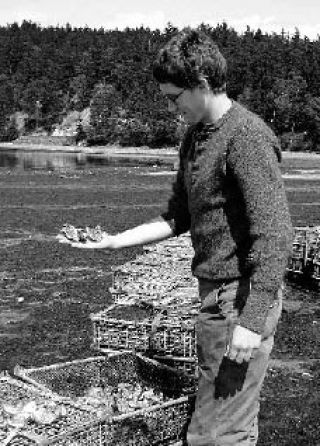Nick Jones checks Sweetwater Shellfish oysters. In the background, Robin Minkler digs clams.
Driving down the center of Lopez past all the open farmland, it’s easy to forget that we live on an island edged with beaches. On a recent afternoon Nick Jones, who with his wife Sara owns and operates Sweetwater Shellfish Farm, introduced me to these beaches as another kind of farmland that has been producing food for thousands of years.
While Nick and Sara have been land farmers since 2002, raising grass-fed beef, goat, pork and poultry, they’ve also been sea farmers since 2004 and have found great satisfaction in farming with the sea and producing and marketing top quality shellfish.
As we sat on a bench and looked out at the Shoal Bay tide flats where Sweetwater Shellfish Farm raises oysters and clams, Nick described the research that led them to acquire this business and then added, “What we didn’t anticipate is just how much we’d fall in love with the process and how satisfying and interesting it has been.
“Farming shellfish basically means purchasing seed and staging it so that these animals can take advantage of the natural processes,” Nick explained. From where we sat, we could see cylindrical mesh drums sealed tightly at each end and arranged like logs in the lagoon and on the near beach. Further out on the beach were larger, rectangular versions of these drums stacked three deep. All contained oysters at various stages of growth. Sheets of half-inch netting covering the beach in front of us marked places where clams were growing in the sand. From seed to harvest for their oysters is one-and-a-half to two years and for their clams two years or more.
The natural processes Nick referred to are the plankton-rich waters that wash over these seedbeds with the daily tides, feeding the oysters and clams. “We have a really unique combination of fairly warm, highly productive and extremely clean, well-flushed water,” Nick said, marveling at their good fortune.
“What we’re growing is local agriculture and we’re very focused on local markets,” Nick said, “but the quality of what is produced here in the San Juans is really world class. Westcott Bay on San Juan, Judd Bay on Orcas: you get talking to folks out in the world and you learn that what we have here in the county is a distinctive flavor. It’s radically different even from Samish Bay.”
Marketing and selling their Lopez Island Sweetwater Shellfish “has been a really fun process because we’ve had to educate ourselves about the shellfish world,” Nick continued. “We’ve always loved seafood and shellfish but we never went out to oyster bars. Developing a little bit of a palate has been a joy.”
A year ago, after their first big harvest, Nick called Jon Rowley, a Seattle-based seafood connoisseur. “We went around to some oyster bars and tasted ours and compared them with others and he gave me feedback. He said our oysters are completely unique. That’s as much as you could hope for. From a marketing perspective you want something that is distinctive.”
Currently they sell their products to a variety of markets in San Juan County. The bulk of their off-island sales are distributed through Mutual Fish Company in Seattle. “We’re working to grow a specific oyster for them. We love doing business in the county and love our local customers but there is something extremely challenging and satisfying about working with people who are in the business of comparing and evaluating food products. Mutual only handles product that is of superlative quality and working with them has been a great educational process for us.”
Another thing that’s satisfying is working with a food resource that has fed people for thousands of years. Pointing to the middens that surround his beach, Nick concluded: “It’s pretty incredible to be part of that continuum.”
To buy Sweetwater Shellfish Farms oysters and clams here on Lopez, watch for the opening of Nick and Sara’s farm stand at 1454 Mud Bay Road.



